Home / Nucleophilic Addition To Carbonyls
Aldehydes and Ketones
Nucleophilic Addition To Carbonyls
Last updated: April 12th, 2025 |
Nucleophilic Addition To Carbonyls
- The most important reaction of the carbonyl group (C=O) is the addition of nucleophiles to the carbonyl carbon, sometimes called, “1,2-addition”.
- Nucleophilic addition changes the hybridization of the carbon from sp2 to sp3 and the geometry from trigonal planar to tetrahedral.
- Depending on the basicity of the nucleophile, addition may be irreversible (e.g. with hydride and alkyl groups) or reversible (e.g. with HO- , alcohols, (-)CN).
- The reverse process is elimination, or often, “1,2-elimination”.
- The rate of addition is increased by adjacent electron-withdrawing groups, and decreased by adjacent electon-donating groups.
- The rate is also decreased by steric factors.
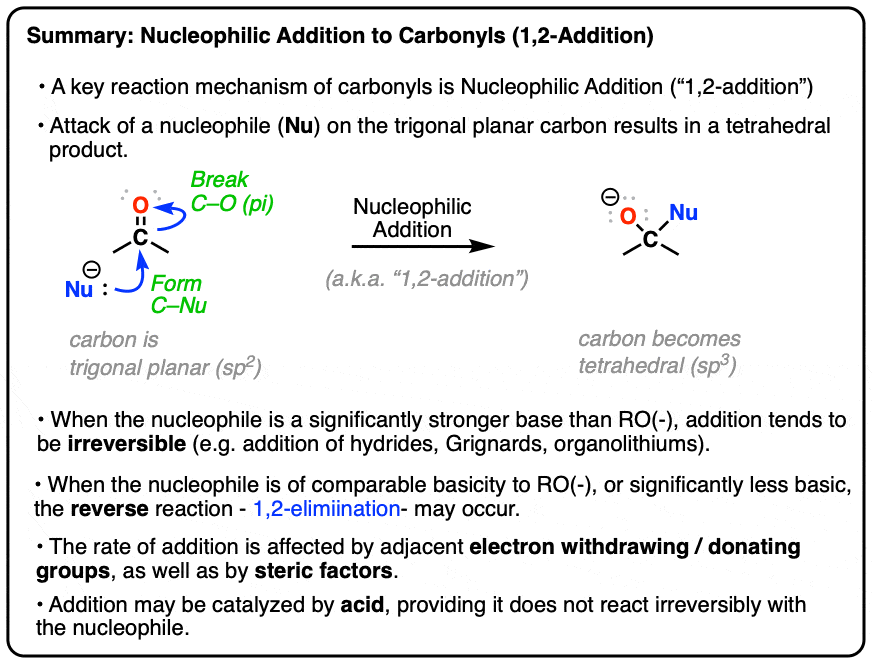
Table of Contents
- Properties of the Carbonyl Group
- Nucleophilic Addition (1,2-Addition) To Carbonyls
- Irreversible Addition With Strong Bases
- Reversible Addition
- Factors Affecting The Rate of Addition: Electronic Effects
- Factors Affecting The Rate of Addition: Steric Effects
- Addition of Neutral Nucleophiles
- Summary
- Notes
- Quiz Yourself!
- (Advanced) References and Further Reading
1. Properties of The Carbonyl (C=O) Group
A C=O bond is referred to as a carbonyl group. They are found in aldehydes, ketones, carboxylic acids and their many derivatives.
Due to the significantly higher electronegativity of oxygen (3.5) relative to carbon (2.5), the electrons in the C=O bond are highly polarized towards oxygen.
This is reflected in the partial positive charge found on the carbon and the partial negative charge on oxygen.

Carbonyl groups have a significant resonance form where there is a positive charge on carbon and a negative charge on oxygen.
The resonance form with a negative charge on carbon and a positive charge on oxygen should never be drawn as it represents less than a full octet on oxygen which is very energetically unfavorable.
2. Nucleophilic Addition To Carbonyls
The carbonyl carbon is an excellent electrophile and will undergo reactions with a large variety of nucleophiles.
This reaction is called, “nucleophilic addition”, or sometimes, “1,2-addition”.
In this reaction a C-Nu bond is formed and the C-O pi bond breaks. The geometry of the carbon goes from trigonal planar to tetrahedral. After addition, the oxygen bears a negative formal charge.
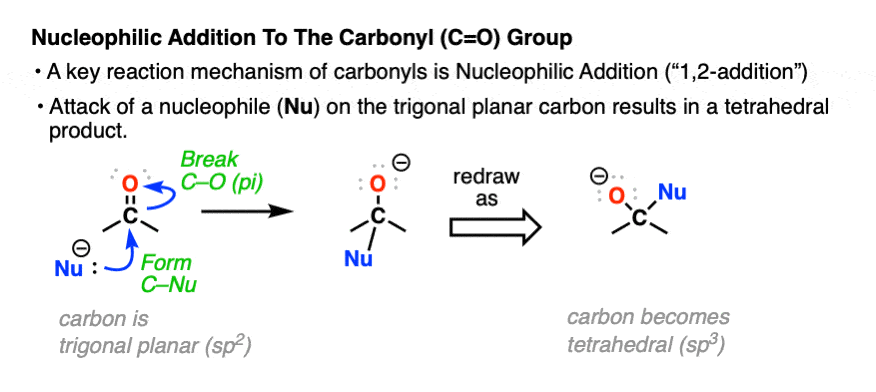
For example aldehydes and ketones undergo addition with cyanide ion to give cyanohydrins.

The importance of this mechanism in carbonyl chemistry cannot be stressed enough. Make sure you know how to draw the curved arrows for this reaction!
 Click to Flip
Click to Flip

It is also possible for the addition product to undergo reversion back to the starting nucleophile and carbonyl.
This reverse process is known as elimination, or “1,2-elimination”. In this mechanistic step, the C-LG bond is broken and a C-O pi bond is formed.
(Remember that a leaving group is essentially just a nucleophile acting in reverse)
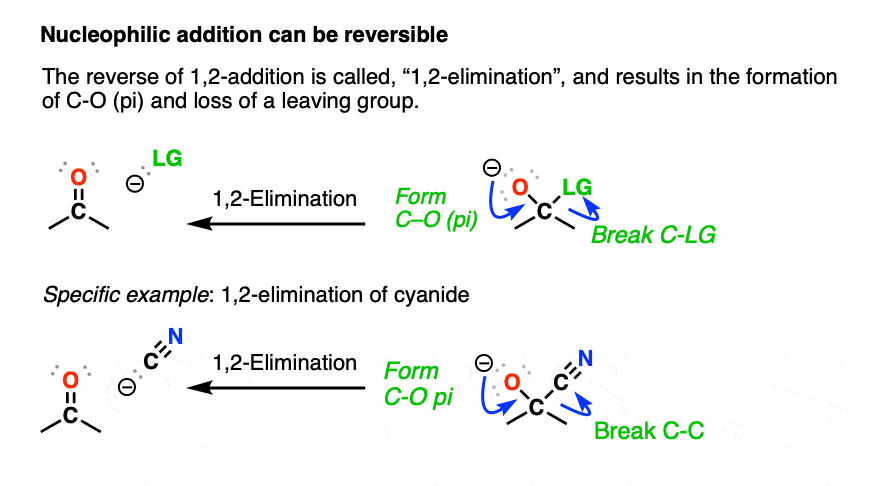
Taken together, 1,2-addition and 1,2-elimination are the two most important mechanistic steps in the chemistry of the carbonyl group and they are found in a large number of mechanisms.
3. Irreversible Nucleophilic Addition
Comparing the relative basicity of the starting nucleophile Nu(-) to that of the negatively charged oxygen on the product can be extremely helpful in determining the position of the equilibrium.
Just as in acid-base reactions, where the favored equilibrium is that where a stronger acid and a stronger base give a weaker acid and a weaker base, nucleophilic addition reactions that result in the formation of a weaker base will be favored.
When the nucleophile happens to be a very strong base, addition reactions are essentially irreversible.
A prime example is the reduction of aldehydes and ketones by sodium borohydride, NaBH4.
The pKa of the H2, the conjugate acid of the hydride ion H(-) is about 36 and the pKa of ROH, the conjugate acid of the resulting alkoxide is roughly 16.
From an acid-base perspective, this reaction is favored by about 20 pKa units (1020). The equilibrium runs far to the right. [Note 1]
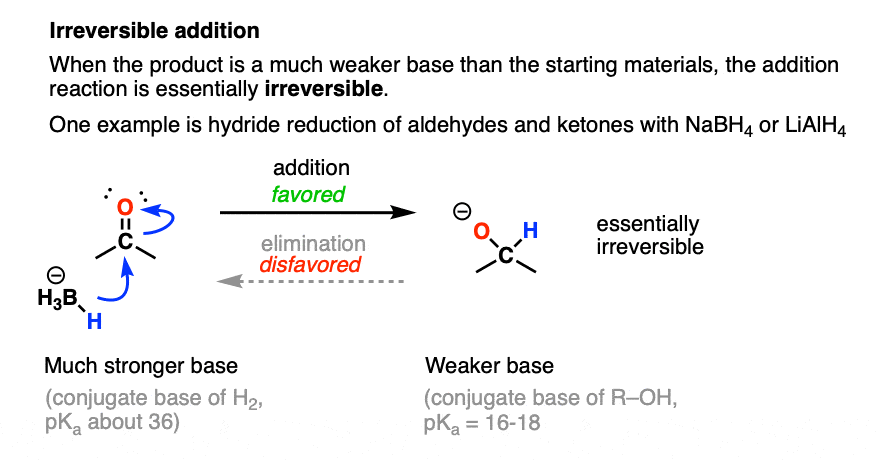
Another example of an irreversible addition is the addition of Grignard or organolithium reagents to aldehydes and ketones.
The pKa of carbanions is about 50. So in this case reverse reaction would be disfavored by about 34 pKa units.

4. Reversible Addition
On the other end of the scale, halide ions such as Cl(-) do not generally add to carbonyls. We can see why by comparing basicities.
The pKa of HCl, the conjugate acid of Cl(-) is -8. The pKa of a typical alcohol ROH is in the range of 16-18. Addition of a halide ion would result in the formation of a stronger base from a weaker base, which is energetically unfavorable.
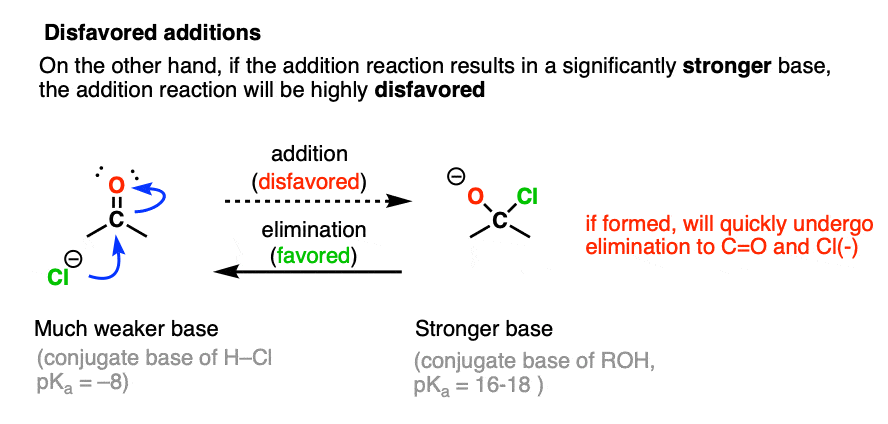
When the basicity of the nucleophile is comparable to the basicity of the product, an equilibrium will result.
This is the case with the addition of hydroxide, alkoxide, and cyanide ions.
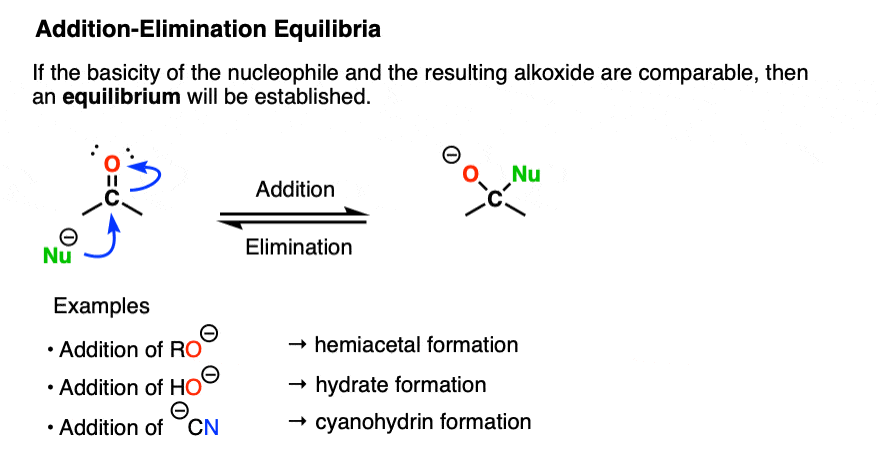
What’s meant by comparable? A good rule of thumb is contained in [Note 2]
5. Factors Affecting The Rate Of Nucleophilic Addition. Electronic effects
The rate of addition of nucleophiles to carbonyl compounds is greatly affected by the neighboring substituents.
On one hand, the more electron-poor the carbonyl carbon is, the greater will be its reactivity towards nucleophiles. For example, we should expect the reactivity in the series acetaldehyde versus trichloroacetaldehyde versus trifluoroacetaldehyde to increase with the increasing inductive effects of the substituents.
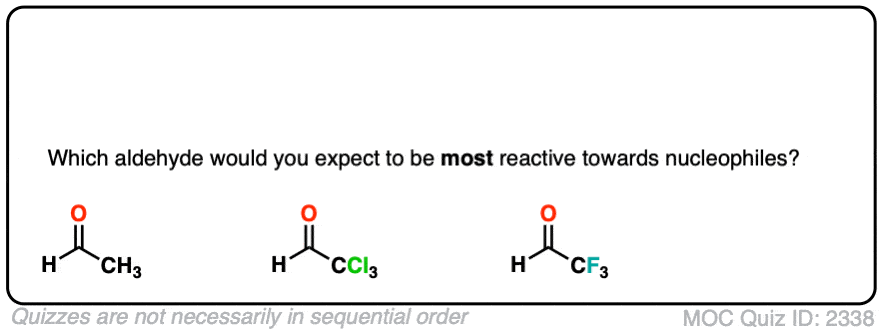 Click to Flip
Click to Flip

Going in the reverse direction, we should expect electron-releasing substituents to have the opposite effect.
You may recall that alkyl groups are activating in electrophilic aromatic substitution because they stabilize adjacent carbocations, relative to hydrogen.
Purely based on this electronic effect we’d therefore expect addition to be faster to aldehydes than to a comparable ketone (and it is! although steric effects also play a role).
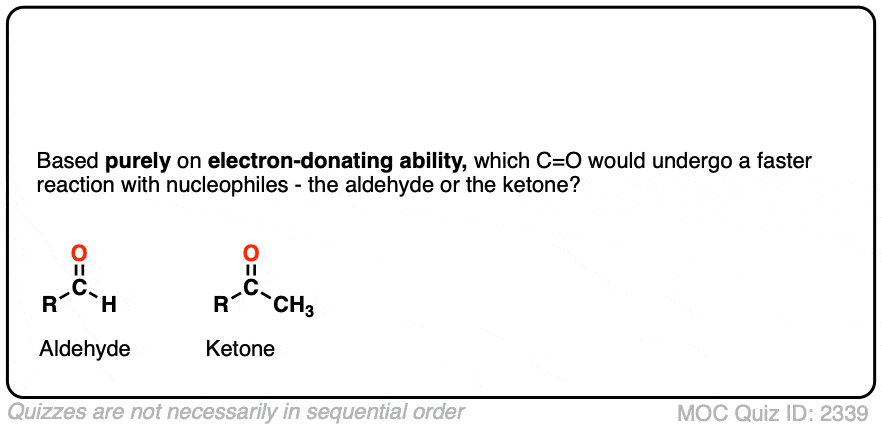 Click to Flip
Click to Flip
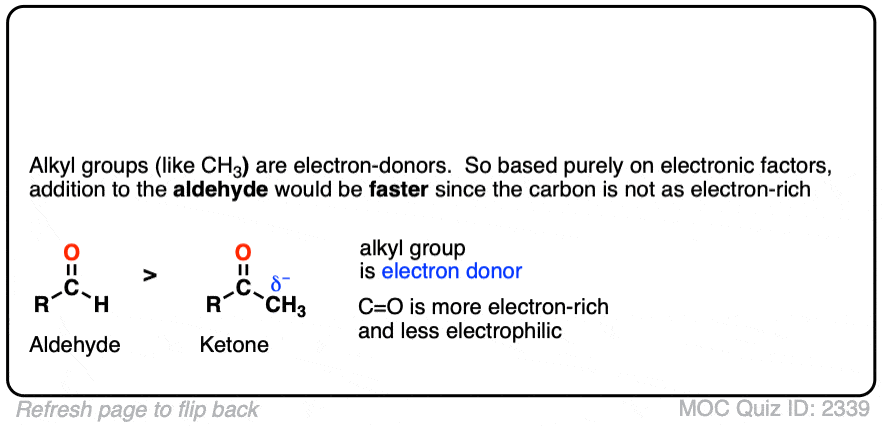
You could use similar reasoning to predict the relative reactivity of esters, amides, and carboxylates. [Note 3].
6. Factors Affecting The Rate Of Nucleophilic Addition: Steric effects
The rate of addition to carbonyls is also affected by the presence of any group which can block the approach of the incoming nucleophile. These are referred to as steric effects.
One prominent example is the addition of nucleophiles to aldehydes versus ketones. Addition to ketones is considerably slower. [Note 4]
If we bulk our ketone up even more to include, say, adjacent t-butyl groups, the rate will be even further impeded. [Note 5]
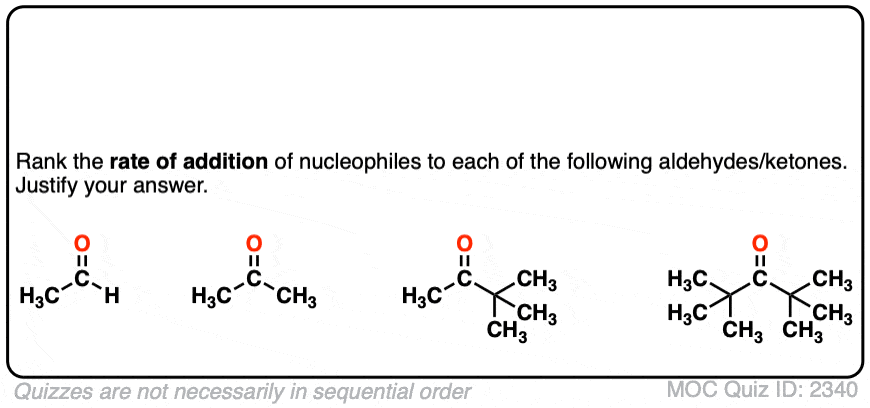 Click to Flip
Click to Flip
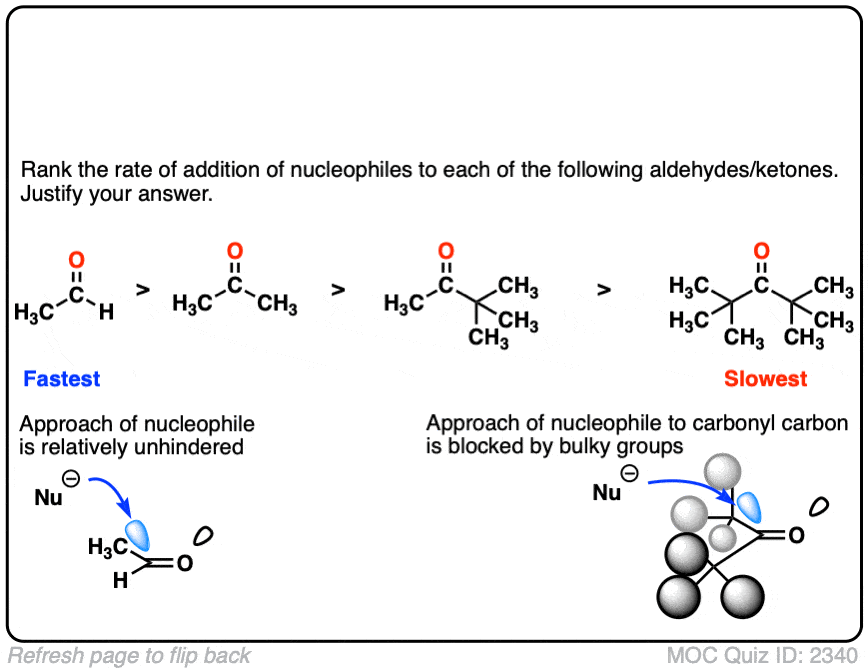
7. Neutral Nucleophiles
Addition to carbonyls is not limited to negatively charged nucleophiles. Neutral nucleophiles such as alcohols and amines are very much capable of adding to carbonyls.
The arrow-pushing mechanism of nucleophilic addition remains the same.
Note, however, that the product will bear an additional positive formal charge. These reactions are generally reversible and are best described as equilibrium reactions. [Note 6]

Generally speaking, neutral species are poorer nucleophiles than their conjugate bases.
The rate of addition can be increased by using an acid catalyst.
Otherwise, the mechanism for addition remains exactly the same.
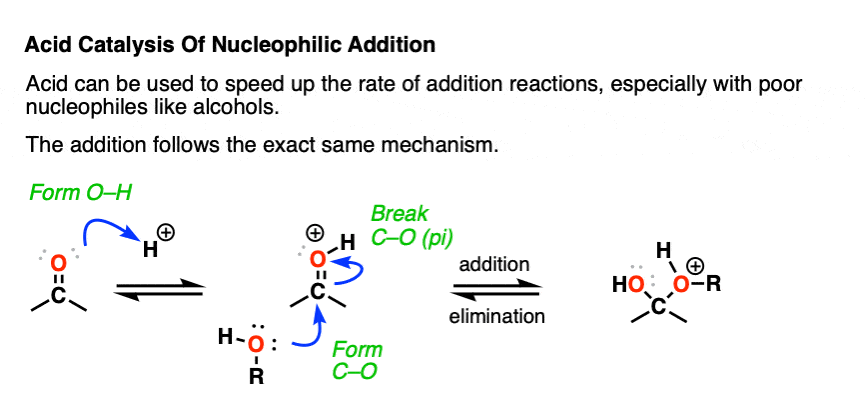
Note that acid catalysis only works for nucleophiles that are not destroyed by acid-base reactions!
8. Summary
Nucleophilic addition is the most important reaction of carbonyls. Not just aldehydes and ketones, but also carboxylic acid derivatives in general.
- Carbonyls undergo addition reactions with a large range of nucleophiles.
- Comparing the relative basicity of the nucleophile and the product is extremely helpful in determining how reversible the addition reaction is. Reactions with Grignards and hydrides are irreversible. Reactions with weak bases like halides and carboxylates generally don’t happen.
- Electronic effects (inductive effects, electron donation) have a large impact on reactivity.
- Large groups adjacent to the carbonyl will slow the rate of reaction.
- Neutral nucleophiles can also add to carbonyls, although their additions are generally slower and more reversible. Acid catalysis is sometimes employed to increase the rate of addition.
Notes
Related Articles
- Aldehydes and Ketones: 14 Reactions With The Same Mechanism
- Addition-Elimination Mechanisms With Neutral Nucleophiles (Including Acid Catalysis)
- Hydrates, Hemiacetals, and Acetals
- Imines – Properties, Formation, Reactions, and Mechanisms
- Aldol Addition and Condensation Reactions
- Claisen Condensation and Dieckmann Condensation
- The Michael Addition Reaction and Conjugate Addition
- Wittig Reaction
Note 1. This is broadly true, but there are some exceptions. The mechanism of the Cannizarro reaction involves a concerted hydride transfer from an aldehyde addition product to give a mixture of an ester and an alcohol.
Note 2. Not precise, but a decent rule of thumb is about 10 pKa units on either side of the basicity of the alkoxide. The pKa of HCN is about 9 and the pKa of alkoxides is in the 16-18 range. On the other end, retro-Claisen reactions are known, and the pKa of ester enolates is about 25.
Note 3. It may seem strange when you think about it, but if you make a ranked list of activating groups for electrophilic aromatic substitution:
Cl (least activating) < H < alkyl < OR < NH2, NHR, NR2 < O(-) (most activating)
it correlates inversely with the rate of addition of nucleophiles to carbonyls R-C(O)–X.
That is
RCOCl (fastest) > H > alkyl > OR > NH2, NHR, NR2< O(-) (undergoes slowest addition).
Activating groups are very good at stabilizing carbocations. The more electron-density they can donate to a carbocation, the less electron-poor it is.
Think of the carbonyl in its 2nd-best resonance structure as a carbocation with an O(-) attached. The better the group X is at donating electron density, the less reactive towards nucleophiles it will be.
Note 4. H.C. Brown studied the relative rates of reduction of aldehydes and ketones and found aldehydes to be much more reactive. See reference.
Note 5. Although not explicitly discussed here the angle of approach of nucleophiles to carbonyls is about 105°, a value now known as the Burgi Dunitz angle or trajectory. This coincides with the position of the C-O pi* orbital, which accepts the pair of electrons from the nucleophile.
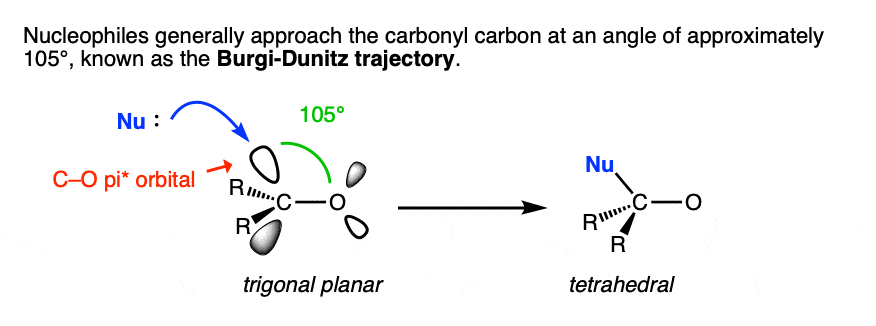
Note 6. The equilibria is subject to several key factors. One obvious one is concentration. By swamping the carbonyl with nucleophile, one can push the addition reaction forward. One way to push condensation reactions (e.g. imine formation) forward is to sequester the H2O that is formed through the use of a drying agent or distillation. Adding acid increases the rate of addition and can affect the equilibrium. A subtle effect is that of intramolecular reactions, which tend to spontaneously form 5- and 6- membered hemiacetals when possible due to entropic factors. Heat can play a role.
Quiz Yourself!

Become a MOC member to see the clickable quiz with answers on the back.

Become a MOC member to see the clickable quiz with answers on the back.
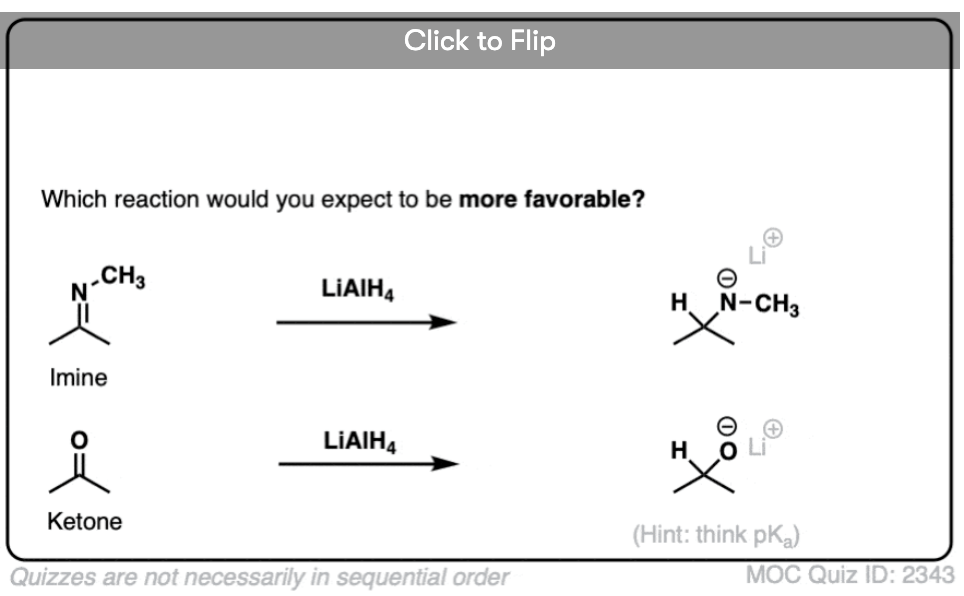
Become a MOC member to see the clickable quiz with answers on the back.
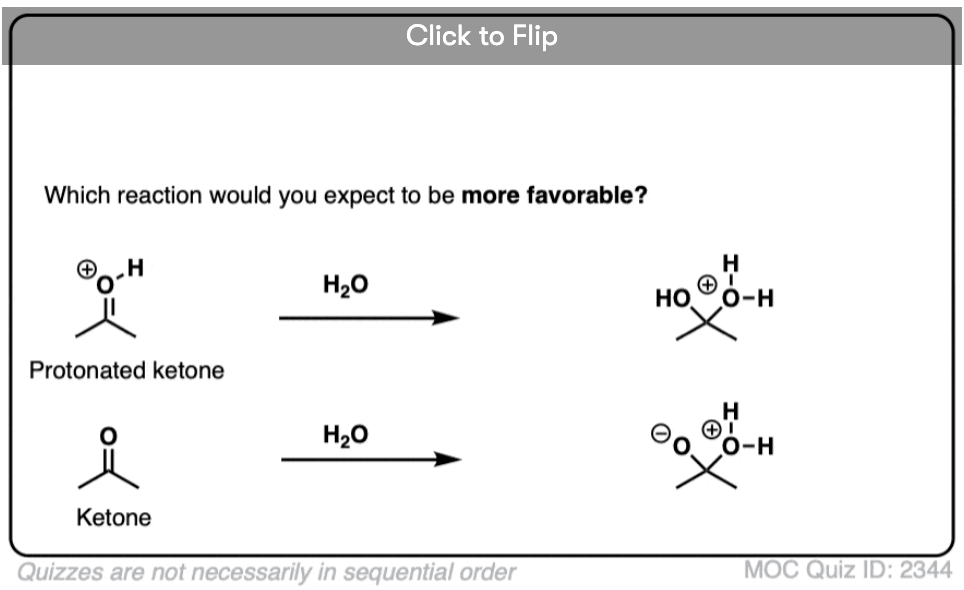
Become a MOC member to see the clickable quiz with answers on the back.
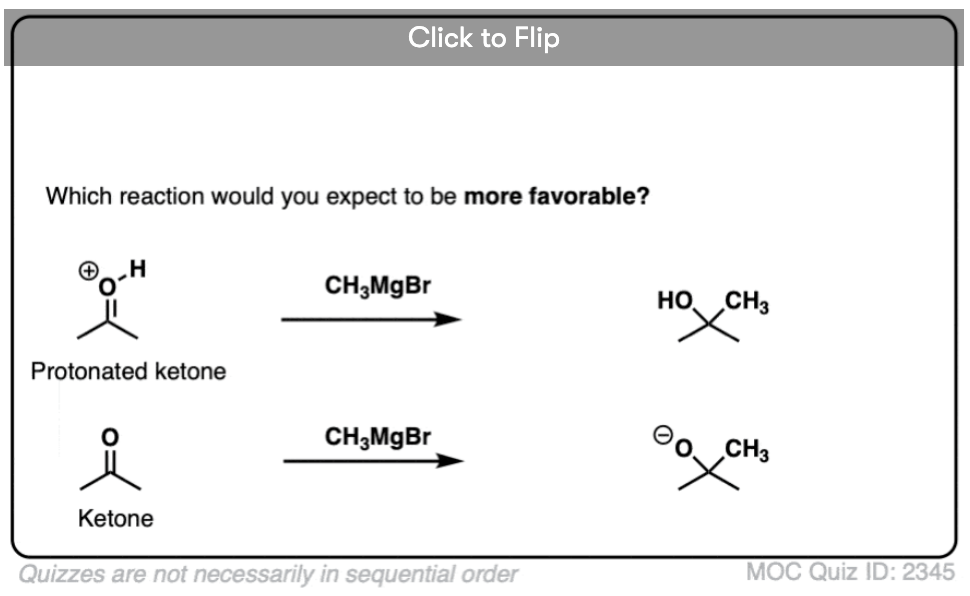
Become a MOC member to see the clickable quiz with answers on the back.
(Advanced) References and Further Reading
1.XCVI.—Reactions involving the addition of hydrogen cyanide to carbon compounds
Arthur Lapworth
J. Chem. Soc., Trans., 1903,83, 995-1005
DOI: 10.1039/CT9038300995
2.CXXII.—Reactions involving the addition of hydrogen cyanide to carbon compounds. Part II. Cyanohydrins regarded as complex acids
Arthur Lapworth
J. Chem. Soc., Trans., 1904,85, 1206-1214
DOI: 10.1039/CT9048501206
Lapworth was among the first to recognize the role of base in catalyzing the addition of HCN to aldehydes and ketones, and also understood that the reaction was reversible.
3. Stereochemistry of reaction paths at carbonyl centres
H.B. Burgi, J.D. Dunitz, J.M. Lehn, G. Wipff,
Tetrahedron, 30(12) 1974, 1563-1572.
DOI: 10.1016/S0040-4020(01)90678-7
A detailed study of crystal structures unveiled a tendency for nucleophiles to approach carbonyl centers at an angle of approximately 105°. This trajectory of the nucleophile towards the C=O bond, which has become known as the Burgi Dunitz trajectory, is proposed to maximize overlap with the C-O pi* bond and allows for relaxation of the carbonyl carbon to a tetrahedral geometry.
4. Chemical Effects of Steric Strains
H. C. Brown, O. H. Wheeler, K. Ichikawa
Tetrahedron 1 1957, 214-220.
DOI: 10.1016/0040-4020(57)88041-7
Study on the reaction rates of reduction of various aldehydes and ketones toward sodium borohydride. Spoiler: Aldehydes are much faster.
00 General Chemistry Review
01 Bonding, Structure, and Resonance
- How Do We Know Methane (CH4) Is Tetrahedral?
- Hybrid Orbitals and Hybridization
- How To Determine Hybridization: A Shortcut
- Orbital Hybridization And Bond Strengths
- Sigma bonds come in six varieties: Pi bonds come in one
- A Key Skill: How to Calculate Formal Charge
- The Four Intermolecular Forces and How They Affect Boiling Points
- 3 Trends That Affect Boiling Points
- How To Use Electronegativity To Determine Electron Density (and why NOT to trust formal charge)
- Introduction to Resonance
- How To Use Curved Arrows To Interchange Resonance Forms
- Evaluating Resonance Forms (1) - The Rule of Least Charges
- How To Find The Best Resonance Structure By Applying Electronegativity
- Evaluating Resonance Structures With Negative Charges
- Evaluating Resonance Structures With Positive Charge
- Exploring Resonance: Pi-Donation
- Exploring Resonance: Pi-acceptors
- In Summary: Evaluating Resonance Structures
- Drawing Resonance Structures: 3 Common Mistakes To Avoid
- How to apply electronegativity and resonance to understand reactivity
- Bond Hybridization Practice
- Structure and Bonding Practice Quizzes
- Resonance Structures Practice
02 Acid Base Reactions
- Introduction to Acid-Base Reactions
- Acid Base Reactions In Organic Chemistry
- The Stronger The Acid, The Weaker The Conjugate Base
- Walkthrough of Acid-Base Reactions (3) - Acidity Trends
- Five Key Factors That Influence Acidity
- Acid-Base Reactions: Introducing Ka and pKa
- How to Use a pKa Table
- The pKa Table Is Your Friend
- A Handy Rule of Thumb for Acid-Base Reactions
- Acid Base Reactions Are Fast
- pKa Values Span 60 Orders Of Magnitude
- How Protonation and Deprotonation Affect Reactivity
- Acid Base Practice Problems
03 Alkanes and Nomenclature
- Meet the (Most Important) Functional Groups
- Condensed Formulas: Deciphering What the Brackets Mean
- Hidden Hydrogens, Hidden Lone Pairs, Hidden Counterions
- Don't Be Futyl, Learn The Butyls
- Primary, Secondary, Tertiary, Quaternary In Organic Chemistry
- Branching, and Its Affect On Melting and Boiling Points
- The Many, Many Ways of Drawing Butane
- Wedge And Dash Convention For Tetrahedral Carbon
- Common Mistakes in Organic Chemistry: Pentavalent Carbon
- Table of Functional Group Priorities for Nomenclature
- Summary Sheet - Alkane Nomenclature
- Organic Chemistry IUPAC Nomenclature Demystified With A Simple Puzzle Piece Approach
- Boiling Point Quizzes
- Organic Chemistry Nomenclature Quizzes
04 Conformations and Cycloalkanes
- Staggered vs Eclipsed Conformations of Ethane
- Conformational Isomers of Propane
- Newman Projection of Butane (and Gauche Conformation)
- Introduction to Cycloalkanes
- Geometric Isomers In Small Rings: Cis And Trans Cycloalkanes
- Calculation of Ring Strain In Cycloalkanes
- Cycloalkanes - Ring Strain In Cyclopropane And Cyclobutane
- Cyclohexane Conformations
- Cyclohexane Chair Conformation: An Aerial Tour
- How To Draw The Cyclohexane Chair Conformation
- The Cyclohexane Chair Flip
- The Cyclohexane Chair Flip - Energy Diagram
- Substituted Cyclohexanes - Axial vs Equatorial
- Ranking The Bulkiness Of Substituents On Cyclohexanes: "A-Values"
- Cyclohexane Chair Conformation Stability: Which One Is Lower Energy?
- Fused Rings - Cis-Decalin and Trans-Decalin
- Naming Bicyclic Compounds - Fused, Bridged, and Spiro
- Bredt's Rule (And Summary of Cycloalkanes)
- Newman Projection Practice
- Cycloalkanes Practice Problems
05 A Primer On Organic Reactions
- The Most Important Question To Ask When Learning a New Reaction
- Curved Arrows (for reactions)
- Nucleophiles and Electrophiles
- The Three Classes of Nucleophiles
- Nucleophilicity vs. Basicity
- What Makes A Good Nucleophile?
- What Makes A Good Leaving Group?
- 3 Factors That Stabilize Carbocations
- Equilibrium and Energy Relationships
- 7 Factors that stabilize negative charge in organic chemistry
- 7 Factors That Stabilize Positive Charge in Organic Chemistry
- What's a Transition State?
- Hammond's Postulate
- Learning Organic Chemistry Reactions: A Checklist (PDF)
- Introduction to Oxidative Cleavage Reactions
06 Free Radical Reactions
- Free Radical Reactions
- 3 Factors That Stabilize Free Radicals
- Bond Strengths And Radical Stability
- Free Radical Initiation: Why Is "Light" Or "Heat" Required?
- Initiation, Propagation, Termination
- Monochlorination Products Of Propane, Pentane, And Other Alkanes
- Selectivity In Free Radical Reactions
- Selectivity in Free Radical Reactions: Bromination vs. Chlorination
- Halogenation At Tiffany's
- Allylic Bromination
- Bonus Topic: Allylic Rearrangements
- In Summary: Free Radicals
- Synthesis (2) - Reactions of Alkanes
- Free Radicals Practice Quizzes
07 Stereochemistry and Chirality
- Types of Isomers: Constitutional Isomers, Stereoisomers, Enantiomers, and Diastereomers
- How To Draw The Enantiomer Of A Chiral Molecule
- How To Draw A Bond Rotation
- Introduction to Assigning (R) and (S): The Cahn-Ingold-Prelog Rules
- Assigning Cahn-Ingold-Prelog (CIP) Priorities (2) - The Method of Dots
- Enantiomers vs Diastereomers vs The Same? Two Methods For Solving Problems
- Assigning R/S To Newman Projections (And Converting Newman To Line Diagrams)
- How To Determine R and S Configurations On A Fischer Projection
- The Meso Trap
- Optical Rotation, Optical Activity, and Specific Rotation
- Optical Purity and Enantiomeric Excess
- What's a Racemic Mixture?
- Chiral Allenes And Chiral Axes
- Stereochemistry Practice Problems and Quizzes
08 Substitution Reactions
- Nucleophilic Substitution Reactions - Introduction
- Two Types of Nucleophilic Substitution Reactions
- The SN2 Mechanism
- Why the SN2 Reaction Is Powerful
- The SN1 Mechanism
- The Conjugate Acid Is A Better Leaving Group
- Comparing the SN1 and SN2 Reactions
- Polar Protic? Polar Aprotic? Nonpolar? All About Solvents
- Steric Hindrance is Like a Fat Goalie
- Common Blind Spot: Intramolecular Reactions
- Substitution Practice - SN1
- Substitution Practice - SN2
09 Elimination Reactions
- Elimination Reactions (1): Introduction And The Key Pattern
- Elimination Reactions (2): The Zaitsev Rule
- Elimination Reactions Are Favored By Heat
- Two Elimination Reaction Patterns
- The E1 Reaction
- The E2 Mechanism
- E1 vs E2: Comparing the E1 and E2 Reactions
- Antiperiplanar Relationships: The E2 Reaction and Cyclohexane Rings
- Bulky Bases in Elimination Reactions
- Comparing the E1 vs SN1 Reactions
- Elimination (E1) Reactions With Rearrangements
- E1cB - Elimination (Unimolecular) Conjugate Base
- Elimination (E1) Practice Problems And Solutions
- Elimination (E2) Practice Problems and Solutions
10 Rearrangements
11 SN1/SN2/E1/E2 Decision
- Identifying Where Substitution and Elimination Reactions Happen
- Deciding SN1/SN2/E1/E2 (1) - The Substrate
- Deciding SN1/SN2/E1/E2 (2) - The Nucleophile/Base
- SN1 vs E1 and SN2 vs E2 : The Temperature
- Deciding SN1/SN2/E1/E2 - The Solvent
- Wrapup: The Key Factors For Determining SN1/SN2/E1/E2
- Alkyl Halide Reaction Map And Summary
- SN1 SN2 E1 E2 Practice Problems
12 Alkene Reactions
- E and Z Notation For Alkenes (+ Cis/Trans)
- Alkene Stability
- Alkene Addition Reactions: "Regioselectivity" and "Stereoselectivity" (Syn/Anti)
- Stereoselective and Stereospecific Reactions
- Hydrohalogenation of Alkenes and Markovnikov's Rule
- Hydration of Alkenes With Aqueous Acid
- Rearrangements in Alkene Addition Reactions
- Halogenation of Alkenes and Halohydrin Formation
- Oxymercuration Demercuration of Alkenes
- Hydroboration Oxidation of Alkenes
- m-CPBA (meta-chloroperoxybenzoic acid)
- OsO4 (Osmium Tetroxide) for Dihydroxylation of Alkenes
- Palladium on Carbon (Pd/C) for Catalytic Hydrogenation of Alkenes
- Cyclopropanation of Alkenes
- A Fourth Alkene Addition Pattern - Free Radical Addition
- Alkene Reactions: Ozonolysis
- Summary: Three Key Families Of Alkene Reaction Mechanisms
- Synthesis (4) - Alkene Reaction Map, Including Alkyl Halide Reactions
- Alkene Reactions Practice Problems
13 Alkyne Reactions
- Acetylides from Alkynes, And Substitution Reactions of Acetylides
- Partial Reduction of Alkynes With Lindlar's Catalyst
- Partial Reduction of Alkynes With Na/NH3 To Obtain Trans Alkenes
- Alkyne Hydroboration With "R2BH"
- Hydration and Oxymercuration of Alkynes
- Hydrohalogenation of Alkynes
- Alkyne Halogenation: Bromination and Chlorination of Alkynes
- Oxidation of Alkynes With O3 and KMnO4
- Alkenes To Alkynes Via Halogenation And Elimination Reactions
- Alkynes Are A Blank Canvas
- Synthesis (5) - Reactions of Alkynes
- Alkyne Reactions Practice Problems With Answers
14 Alcohols, Epoxides and Ethers
- Alcohols - Nomenclature and Properties
- Alcohols Can Act As Acids Or Bases (And Why It Matters)
- Alcohols - Acidity and Basicity
- The Williamson Ether Synthesis
- Ethers From Alkenes, Tertiary Alkyl Halides and Alkoxymercuration
- Alcohols To Ethers via Acid Catalysis
- Cleavage Of Ethers With Acid
- Epoxides - The Outlier Of The Ether Family
- Opening of Epoxides With Acid
- Epoxide Ring Opening With Base
- Making Alkyl Halides From Alcohols
- Tosylates And Mesylates
- PBr3 and SOCl2
- Elimination Reactions of Alcohols
- Elimination of Alcohols To Alkenes With POCl3
- Alcohol Oxidation: "Strong" and "Weak" Oxidants
- Demystifying The Mechanisms of Alcohol Oxidations
- Protecting Groups For Alcohols
- Thiols And Thioethers
- Calculating the oxidation state of a carbon
- Oxidation and Reduction in Organic Chemistry
- Oxidation Ladders
- SOCl2 Mechanism For Alcohols To Alkyl Halides: SN2 versus SNi
- Alcohol Reactions Roadmap (PDF)
- Alcohol Reaction Practice Problems
- Epoxide Reaction Quizzes
- Oxidation and Reduction Practice Quizzes
15 Organometallics
- What's An Organometallic?
- Formation of Grignard and Organolithium Reagents
- Organometallics Are Strong Bases
- Reactions of Grignard Reagents
- Protecting Groups In Grignard Reactions
- Synthesis Problems Involving Grignard Reagents
- Grignard Reactions And Synthesis (2)
- Organocuprates (Gilman Reagents): How They're Made
- Gilman Reagents (Organocuprates): What They're Used For
- The Heck, Suzuki, and Olefin Metathesis Reactions (And Why They Don't Belong In Most Introductory Organic Chemistry Courses)
- Reaction Map: Reactions of Organometallics
- Grignard Practice Problems
16 Spectroscopy
- Degrees of Unsaturation (or IHD, Index of Hydrogen Deficiency)
- Conjugation And Color (+ How Bleach Works)
- Introduction To UV-Vis Spectroscopy
- UV-Vis Spectroscopy: Absorbance of Carbonyls
- UV-Vis Spectroscopy: Practice Questions
- Bond Vibrations, Infrared Spectroscopy, and the "Ball and Spring" Model
- Infrared Spectroscopy: A Quick Primer On Interpreting Spectra
- IR Spectroscopy: 4 Practice Problems
- 1H NMR: How Many Signals?
- Homotopic, Enantiotopic, Diastereotopic
- Diastereotopic Protons in 1H NMR Spectroscopy: Examples
- 13-C NMR - How Many Signals
- Liquid Gold: Pheromones In Doe Urine
- Natural Product Isolation (1) - Extraction
- Natural Product Isolation (2) - Purification Techniques, An Overview
- Structure Determination Case Study: Deer Tarsal Gland Pheromone
17 Dienes and MO Theory
- What To Expect In Organic Chemistry 2
- Are these molecules conjugated?
- Conjugation And Resonance In Organic Chemistry
- Bonding And Antibonding Pi Orbitals
- Molecular Orbitals of The Allyl Cation, Allyl Radical, and Allyl Anion
- Pi Molecular Orbitals of Butadiene
- Reactions of Dienes: 1,2 and 1,4 Addition
- Thermodynamic and Kinetic Products
- More On 1,2 and 1,4 Additions To Dienes
- s-cis and s-trans
- The Diels-Alder Reaction
- Cyclic Dienes and Dienophiles in the Diels-Alder Reaction
- Stereochemistry of the Diels-Alder Reaction
- Exo vs Endo Products In The Diels Alder: How To Tell Them Apart
- HOMO and LUMO In the Diels Alder Reaction
- Why Are Endo vs Exo Products Favored in the Diels-Alder Reaction?
- Diels-Alder Reaction: Kinetic and Thermodynamic Control
- The Retro Diels-Alder Reaction
- The Intramolecular Diels Alder Reaction
- Regiochemistry In The Diels-Alder Reaction
- The Cope and Claisen Rearrangements
- Electrocyclic Reactions
- Electrocyclic Ring Opening And Closure (2) - Six (or Eight) Pi Electrons
- Diels Alder Practice Problems
- Molecular Orbital Theory Practice
18 Aromaticity
- Introduction To Aromaticity
- Rules For Aromaticity
- Huckel's Rule: What Does 4n+2 Mean?
- Aromatic, Non-Aromatic, or Antiaromatic? Some Practice Problems
- Antiaromatic Compounds and Antiaromaticity
- The Pi Molecular Orbitals of Benzene
- The Pi Molecular Orbitals of Cyclobutadiene
- Frost Circles
- Aromaticity Practice Quizzes
19 Reactions of Aromatic Molecules
- Electrophilic Aromatic Substitution: Introduction
- Activating and Deactivating Groups In Electrophilic Aromatic Substitution
- Electrophilic Aromatic Substitution - The Mechanism
- Ortho-, Para- and Meta- Directors in Electrophilic Aromatic Substitution
- Understanding Ortho, Para, and Meta Directors
- Why are halogens ortho- para- directors?
- Disubstituted Benzenes: The Strongest Electron-Donor "Wins"
- Electrophilic Aromatic Substitutions (1) - Halogenation of Benzene
- Electrophilic Aromatic Substitutions (2) - Nitration and Sulfonation
- EAS Reactions (3) - Friedel-Crafts Acylation and Friedel-Crafts Alkylation
- Intramolecular Friedel-Crafts Reactions
- Nucleophilic Aromatic Substitution (NAS)
- Nucleophilic Aromatic Substitution (2) - The Benzyne Mechanism
- Reactions on the "Benzylic" Carbon: Bromination And Oxidation
- The Wolff-Kishner, Clemmensen, And Other Carbonyl Reductions
- More Reactions on the Aromatic Sidechain: Reduction of Nitro Groups and the Baeyer Villiger
- Aromatic Synthesis (1) - "Order Of Operations"
- Synthesis of Benzene Derivatives (2) - Polarity Reversal
- Aromatic Synthesis (3) - Sulfonyl Blocking Groups
- Birch Reduction
- Synthesis (7): Reaction Map of Benzene and Related Aromatic Compounds
- Aromatic Reactions and Synthesis Practice
- Electrophilic Aromatic Substitution Practice Problems
20 Aldehydes and Ketones
- What's The Alpha Carbon In Carbonyl Compounds?
- Nucleophilic Addition To Carbonyls
- Aldehydes and Ketones: 14 Reactions With The Same Mechanism
- Sodium Borohydride (NaBH4) Reduction of Aldehydes and Ketones
- Grignard Reagents For Addition To Aldehydes and Ketones
- Wittig Reaction
- Hydrates, Hemiacetals, and Acetals
- Imines - Properties, Formation, Reactions, and Mechanisms
- All About Enamines
- Breaking Down Carbonyl Reaction Mechanisms: Reactions of Anionic Nucleophiles (Part 2)
- Aldehydes Ketones Reaction Practice
21 Carboxylic Acid Derivatives
- Nucleophilic Acyl Substitution (With Negatively Charged Nucleophiles)
- Addition-Elimination Mechanisms With Neutral Nucleophiles (Including Acid Catalysis)
- Basic Hydrolysis of Esters - Saponification
- Transesterification
- Proton Transfer
- Fischer Esterification - Carboxylic Acid to Ester Under Acidic Conditions
- Lithium Aluminum Hydride (LiAlH4) For Reduction of Carboxylic Acid Derivatives
- LiAlH[Ot-Bu]3 For The Reduction of Acid Halides To Aldehydes
- Di-isobutyl Aluminum Hydride (DIBAL) For The Partial Reduction of Esters and Nitriles
- Amide Hydrolysis
- Thionyl Chloride (SOCl2) And Conversion of Carboxylic Acids to Acid Halides
- Diazomethane (CH2N2)
- Carbonyl Chemistry: Learn Six Mechanisms For the Price Of One
- Making Music With Mechanisms (PADPED)
- Carboxylic Acid Derivatives Practice Questions
22 Enols and Enolates
- Keto-Enol Tautomerism
- Enolates - Formation, Stability, and Simple Reactions
- Kinetic Versus Thermodynamic Enolates
- Aldol Addition and Condensation Reactions
- Reactions of Enols - Acid-Catalyzed Aldol, Halogenation, and Mannich Reactions
- Claisen Condensation and Dieckmann Condensation
- Decarboxylation
- The Malonic Ester and Acetoacetic Ester Synthesis
- The Michael Addition Reaction and Conjugate Addition
- The Robinson Annulation
- Haloform Reaction
- The Hell–Volhard–Zelinsky Reaction
- Enols and Enolates Practice Quizzes
23 Amines
- The Amide Functional Group: Properties, Synthesis, and Nomenclature
- Basicity of Amines And pKaH
- 5 Key Basicity Trends of Amines
- The Mesomeric Effect And Aromatic Amines
- Nucleophilicity of Amines
- Alkylation of Amines (Sucks!)
- Reductive Amination
- The Gabriel Synthesis
- Some Reactions of Azides
- The Hofmann Elimination
- The Hofmann and Curtius Rearrangements
- The Cope Elimination
- Protecting Groups for Amines - Carbamates
- The Strecker Synthesis of Amino Acids
- Introduction to Peptide Synthesis
- Reactions of Diazonium Salts: Sandmeyer and Related Reactions
- Amine Practice Questions
24 Carbohydrates
- D and L Notation For Sugars
- Pyranoses and Furanoses: Ring-Chain Tautomerism In Sugars
- What is Mutarotation?
- Reducing Sugars
- The Big Damn Post Of Carbohydrate-Related Chemistry Definitions
- The Haworth Projection
- Converting a Fischer Projection To A Haworth (And Vice Versa)
- Reactions of Sugars: Glycosylation and Protection
- The Ruff Degradation and Kiliani-Fischer Synthesis
- Isoelectric Points of Amino Acids (and How To Calculate Them)
- Carbohydrates Practice
- Amino Acid Quizzes
25 Fun and Miscellaneous
- A Gallery of Some Interesting Molecules From Nature
- Screw Organic Chemistry, I'm Just Going To Write About Cats
- On Cats, Part 1: Conformations and Configurations
- On Cats, Part 2: Cat Line Diagrams
- On Cats, Part 4: Enantiocats
- On Cats, Part 6: Stereocenters
- Organic Chemistry Is Shit
- The Organic Chemistry Behind "The Pill"
- Maybe they should call them, "Formal Wins" ?
- Why Do Organic Chemists Use Kilocalories?
- The Principle of Least Effort
- Organic Chemistry GIFS - Resonance Forms
- Reproducibility In Organic Chemistry
- What Holds The Nucleus Together?
- How Reactions Are Like Music
- Organic Chemistry and the New MCAT
26 Organic Chemistry Tips and Tricks
- Common Mistakes: Formal Charges Can Mislead
- Partial Charges Give Clues About Electron Flow
- Draw The Ugly Version First
- Organic Chemistry Study Tips: Learn the Trends
- The 8 Types of Arrows In Organic Chemistry, Explained
- Top 10 Skills To Master Before An Organic Chemistry 2 Final
- Common Mistakes with Carbonyls: Carboxylic Acids... Are Acids!
- Planning Organic Synthesis With "Reaction Maps"
- Alkene Addition Pattern #1: The "Carbocation Pathway"
- Alkene Addition Pattern #2: The "Three-Membered Ring" Pathway
- Alkene Addition Pattern #3: The "Concerted" Pathway
- Number Your Carbons!
- The 4 Major Classes of Reactions in Org 1
- How (and why) electrons flow
- Grossman's Rule
- Three Exam Tips
- A 3-Step Method For Thinking Through Synthesis Problems
- Putting It Together
- Putting Diels-Alder Products in Perspective
- The Ups and Downs of Cyclohexanes
- The Most Annoying Exceptions in Org 1 (Part 1)
- The Most Annoying Exceptions in Org 1 (Part 2)
- The Marriage May Be Bad, But the Divorce Still Costs Money
- 9 Nomenclature Conventions To Know
- Nucleophile attacks Electrophile
27 Case Studies of Successful O-Chem Students
- Success Stories: How Corina Got The The "Hard" Professor - And Got An A+ Anyway
- How Helena Aced Organic Chemistry
- From a "Drop" To B+ in Org 2 – How A Hard Working Student Turned It Around
- How Serge Aced Organic Chemistry
- Success Stories: How Zach Aced Organic Chemistry 1
- Success Stories: How Kari Went From C– to B+
- How Esther Bounced Back From a "C" To Get A's In Organic Chemistry 1 And 2
- How Tyrell Got The Highest Grade In Her Organic Chemistry Course
- This Is Why Students Use Flashcards
- Success Stories: How Stu Aced Organic Chemistry
- How John Pulled Up His Organic Chemistry Exam Grades
- Success Stories: How Nathan Aced Organic Chemistry (Without It Taking Over His Life)
- How Chris Aced Org 1 and Org 2
- Interview: How Jay Got an A+ In Organic Chemistry
- How to Do Well in Organic Chemistry: One Student's Advice
- "America's Top TA" Shares His Secrets For Teaching O-Chem
- "Organic Chemistry Is Like..." - A Few Metaphors
- How To Do Well In Organic Chemistry: Advice From A Tutor
- Guest post: "I went from being afraid of tests to actually looking forward to them".
Can I conclude from this that a neutral nucleophile will never perform an addition reaction on carbonyl group ( because what we will form will be an alkoxide ion which will be definitely stronger base than a neutral nucleophile)
Neutral nucleophiles can certainly add to carbonyls – for example, water forms hydrates with aldehydes and ketones. It’s just slower.
As far as the formation of the alkoxide, keep in mind that a proton transfer will result in a neutral addition product.